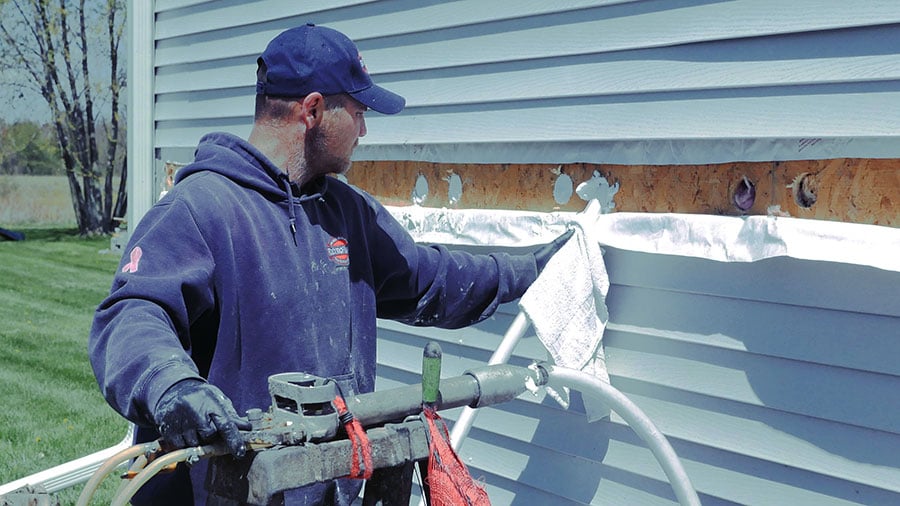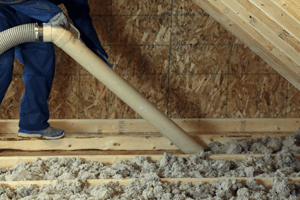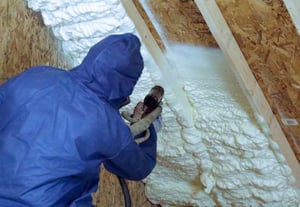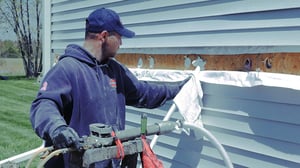How to Insulate an Old House
injection foam insulation | spray foam insulation | existing home insulation


If you live in a state with freezing temperatures in the winter and sweltering heat in the summer, you don’t want to be stuck in an old house with no insulation.
Michigan, and portions of the mid-west and east coast, can have a fluctuation of temperatures in just a week or, in some cases, only a day. When you’re living in an older home – built in the early 1900s to 1950s – in many cases, there is very little or nothing in the attic, walls, or crawl space for insulation.
So how do you insulate an old house?
RetroFoam of Michigan has more than 17 years of experience insulating homes, and the best return on investment we see are from these older homes with no insulation. Adding an air seal to an old house won’t just make it more comfortable, it will save you money on your monthly energy bills.
In our continued efforts to educate homeowners, let’s take a look at how to insulate an old house with foam insulation.
How to Best Insulate an Old House
When insulating your existing home, no matter the age, the main options will be spray foam and injection foam, fiberglass, or cellulose.
The best insulation for an older home that has a lot of drafts is going to be a material that creates an air seal. Spray foam and injection foam are the best options when it comes to making your home energy efficient and comfortable.
Traditional insulation won’t give you the needed air barrier you need to keep your treated air inside and the outside temperatures out where they belong. This is because these materials still allow for air to move through them.
How to Stop Moisture Problems
Older homes tend to have a lot of cracks and gaps throughout the structure from decades of shifting and settling.
Moisture can find its way through these gaps and into your home.
This is why foam insulation is really the best option to seal up the home from the outside. Foam insulation is the only material that will expand into all of the nooks and crannies to fill the cavity completely.
It's important to note, any serious structural damage like very large cracks in the foundation or roof leaks should be taken care of before the foam insulation is installed.
How to Tell if You Need Insulation
Do you have high monthly energy bills, uncomfortable rooms, problems with moisture, mold, and mildew?
These are just some of the signs you need insulation in your home. Other symptoms include a constantly running furnace or air conditioner, cold floors, drafts, and walls that are cold to the touch. Some problems could even lead to structural damage to the roof, like if you notice ice dams forming at the gutters each winter.
If you have some insulation in your home, it is likely if it hasn’t been replaced or maintained in at least 20 years. If that's the case, the insulation has likely shifted, settled, sagged, and likely deteriorated over time.
What Happens to Existing Insulation in the Attic, Walls, and Crawl Space?
 If your older home happens to have existing insulation, in some cases, it will need to be removed, and in others, it will stay where it is.
If your older home happens to have existing insulation, in some cases, it will need to be removed, and in others, it will stay where it is.
For example, anything in your attic, crawl space, or rim joist will need to be removed before the spray foam is applied. Now, if there is fiberglass in the walls, then it can stay right where it is without interfering with the injection foam installation.
There are cases where the exterior walls have blown-in cellulose, and that will need to be removed. If that's the case, then crews will vacuum out as much of the material as they are able.
Let’s talk about the crawl space and the attic first.
If the traditional insulation in these areas has become wet, then it will need to be removed due to mold and mildew issues. You will be able to tell as it will look wet and possibly have black spots throughout as the mold grows.
An added benefit of removing all of that old insulation is you're also getting rid of all of the dust and allergens that were inside those materials.
Over time cellulose and fiberglass will shift, settle, and sag. If that’s the case, you can add more insulation, but you’ll have to make sure you maintain the cellulose with raking and ensure the fiberglass is properly cut and installed.
When it comes to the walls of your home, you can add more insulation while leaving the original intact. If you want to add insulation without tearing down your drywall, you can use blown-in materials.
If you want energy efficiency, comfort, and an air barrier, foam insulation is the best option.
Insulating an Old House: Process and Areas to Install
When it comes to installing foam insulation in your older home, you should insulate from the very top all the way to the bottom.
This method seals the home's entire building envelope and includes the attic, walls, rim joist, and crawl space. If you want to eliminate air leakage in your home, it doesn’t make sense to leave any area uninsulated.
Now let’s talk about the installation process.
Insulating the Attic of an Old House
 Typically, older homes have a larger attic space, which may seem easy to install because there is more room to work, but there are gaps to worry about.
Typically, older homes have a larger attic space, which may seem easy to install because there is more room to work, but there are gaps to worry about.
There will be gaps in the roof deck and by the soffits.
Any time you have gaps, even if it’s only a half-inch, that is a space the foam will get into.
There is an easy fix, the installation crew will take more time to find those gaps, and either use a canned foam to seal them or use plastic to cover them to avoid the spray foam getting into places where it shouldn’t be.
When insulating the attic, you have two choices - to insulate the roof deck or the attic flat.
If you want the attic to be part of your conditioned space because you plan to use it for storage, then the roof deck is the best option. If you have no plans for the attic, the flat can be sprayed, cutting the space off from the rest of the conditioned living space.
Insulating Old House Walls
The walls in an old house can add some complications to the install process, but it’s nothing a good contractor can’t handle.
Almost every old house has double and triple studs. So, when crews take the siding off and drill into the house. The double and triple studs just add extra drilling time for the crews to ensure the job is done correctly.
Another thing crews find with older homes is a lot of nails. Because they use an auger-style bit that grinds the wood out when that bit hits a nail, it stops. When crews know they are working on an older home, they make sure to bring extra drills.
 The process of insulating an older home's exterior walls or a newer existing home is basically the same, aside from the things we just discussed.
The process of insulating an older home's exterior walls or a newer existing home is basically the same, aside from the things we just discussed.
The type of siding your home has can change the installation process from the technique used to the amount of time it takes to complete the job. We work with vinyl, aluminum, brick, wood, as well as slate tiles and stucco.
The injection foam insulation can be installed in your exterior walls from the outside, so you don’t have to worry about taking down any drywall.
Crawl Space and Rim Joist Insulation in an Old House
One thing that stands out in older homes is the crawl space is usually what’s referred to as a Michigan crawl space or a Michigan basement.
This refers to a crawl space or basement that has stone walls. Sometimes there is a dirt floor or concrete, and the walls are shorter – around 5-feet-tall.
These stone walls can be sprayed with foam insulation, just like any other surface to create an air seal.
Much like the attic, there are two options when insulating a crawl space -- either spray the walls and rim joist or spray under the floor and rim joist.
If there are mechanicals or ductwork in the crawl space, then it is recommended to lay plastic on the floor and spray the walls. This method seals off the foundation of the home and ensures the crawl space will be the same temperature as the rest of the house.
If there aren't any mechanicals or ductwork, then the better option is to insulate the crawl space ceiling. This method creates an air seal that cuts the crawl space off from the rest of the house.
Learn More About Foam Insulation
For owners of older homes, it is important to keep the character of their old home while bringing the comfort level and energy efficiency into the 21st century with the right insulation.
Maintaining that old farmhouse aesthetic is important, and it's important to hire an insulation contractor who will keep that in mind, leaving the home looking just like it did before the work began. Leaving the homeowner with their rustic-looking house with new insulation that will make it more comfortable and energy-efficient.
If you want to learn more about the benefits of foam insulation, check out the Learning Center on our website.
Related Articles
Spray Foam Insulation a Must Have in Alma Farmhouse Renovation
What are the Best Places to Insulate Your Home?
Foam vs Fiberglass vs Cellulose: Which Insulation is Best for My Existing House?
About Amanda Emery
Amanda previously has worked as a breaking news and crime reporter, TV news producer, and editor in Flint and Detroit. Throughout her career as a journalist, she has won several awards from The Society of Professional Journalists - Detroit Chapter and the Michigan Press Association. As part of the RetroFoam of Michigan family, Amanda uses her experience as a journalist to write content that will help educate homeowners on the benefits of foam insulation. When Amanda isn’t writing, she’s spending time with her husband and rescued huskies. She also loves knitting, making art, cooking, and hosting dinner and a movie night for friends and family.




